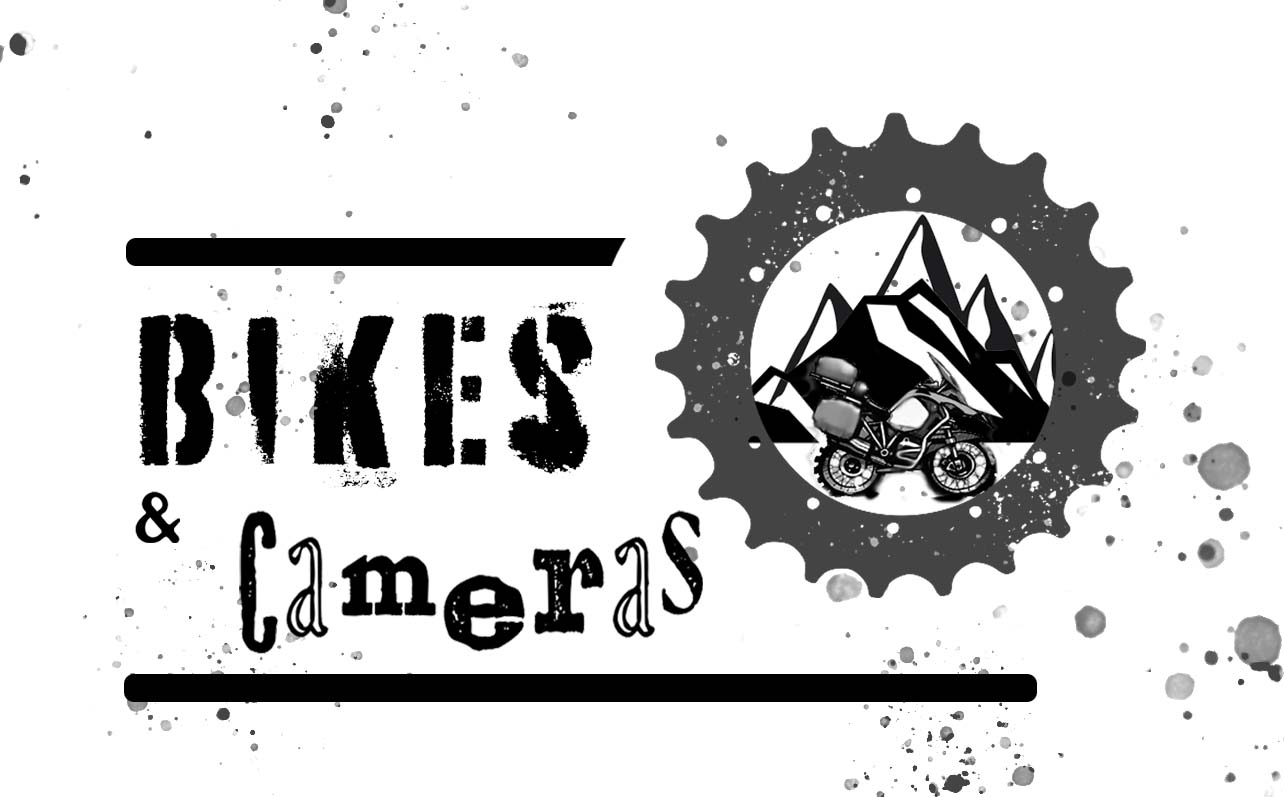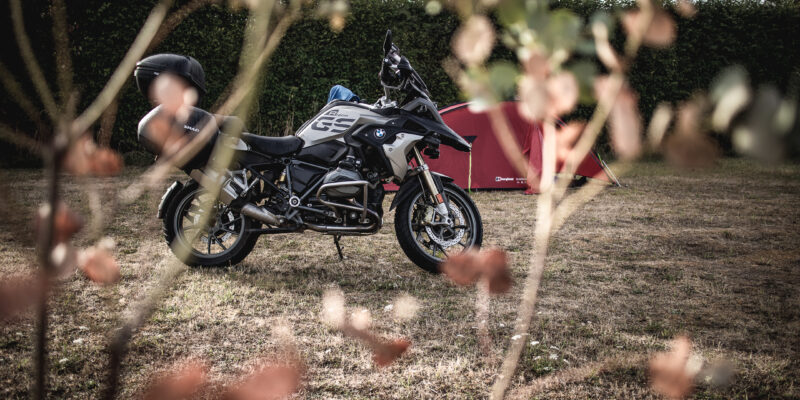This is my motorcycle kit list. There are many like it, but this one is mine.
What you choose to take with you when you go camping on a motorcycle is going to be very specific to you and what you find works for you. The only real way to get the right kit for you is to keep going out and trying it on new trips, changing and optimising.
My first tip though, before diving in – is that it’s okay for your kit to not be perfect the first time. The truth is, there really is no perfect kit. There’s always some kind of compromise you have to make whether that’s weight, or space, or leaving some else behind. With all that said – here’s the kit I take at the moment when I’m motorcycle camping.
First off – this kit is for camping in serviced campsites, in Europe – it’s not a wild camping list, but I suppose there’s no reason it couldn’t be.
Secondly, this is about achieving comfort over a week long tour. I probably could live on this kit for an extended period of time. But I probably wouldn’t. That’s just me. So anyway, here we go.
Tent: Berghaus Cairngorm 2 man tent

Tents – pretty key piece of camping equipment for I’m going to say most people wanting to camp. Someone will come along and chat something about bivvies, or hammocks in a minute, but whatever. Buy a tent.
The basic trade-off with tents is living space vs weather resistance vs bike carrying capacity.
Unless you’re riding two up – you can realistically get a decent size tent on your passenger seat as big as you’re ever really want one. Space in your tent does make a significant different to your comfort, being able to stand, have plenty of space for your gear, maybe even park your bike inside – all of these things can be nice creature comforts.
There’s a couple of big downsides for me though in larger tents, and solo bike camping.
The biggest and most important to me, is weather resilience. I’m not talking waterproofing, I’m talking how your tent behaves when it’s both windy and rainy. Larger tents don’t tend to be anywhere near as sturdy in the wind, they flap around and can be super noisy when the weather turns bad. This make the tent feel windy on the inside as well as the outside and makes for an all round unpleasant night.
The second is how quick and easy they are to pitch. Larger tents tend to be more of a faff to pitch. This can be fine for one or two nights, but if you’re moving campsites every night for a week on tour, this gets very old very fast when you’re putting away, or more typically when you’re trying to put up your tent at the end of a long days riding for the 4th or fifth time in a row.
I therefore opt for a smaller, two man, freestanding dome type tent. That is decently sturdy in the wind, and easy to put up and pull down. A porch area is a good thing to have to take your boots on and off in a relatively dry space without dragging all the much into the tent.
The Berghaus Cairngorm 2 is a super sturdy shape, if anything it’s maybe a touch too small – a tiny bit of extra space would just make it easier to manoeuvre around in. But it does have a decently small pack size. It comes in at around £200 – I’m a believer that is about the right price point for a decent tent as you go higher than that, you start to get into some very specialty tents that are ultra light or ultra something else, and actually start to make some significant compromises to deliver that ‘ultra whatever it is’ that you don’t really need, particularly as you can generally carry it on your bike.
Sleep system (ie. Bed stuff)
There are 3 things that are important to me with how I put my bed together for the night.
- Air mattress
- Sleeping bag
- Pillow

Remember when you were a kid, and you had one of those foam roll mats, maybe 7 or 8mm thick? Yeah, don’t be a hero and think that is the way to camp in the 2020’s
Air mattress is the way forward. I use a trekology one that costs about £45 on Amazon and it’s been great/. You can pay as much or as little as you feel appropriate, but I highly recommend an air matress over any other kind of camping mat type system. I’ve tried the self inflating mats, they’re crap, no where near as comfortable and don’t pack down anywhere near as small. For bonus points, check out this tiny air pump – the one I have stayed charged for a whole week of blowing my mattress up, and is super small you are really making no trade off at all.
For sleeping bags I have a reasonable 3 season one, rated down to about -3 for the ‘survival’ rating. You don’t want to be on the edge of survival. You want the warmest you can afford. For bike camping, a down sleeping bag was a good investment for me – it packs down smaller and gives more warmth than a synthetic – but is that bit more expensive.
Pillow. I’ve tried the inflatable pillows, I’ve tried stuffing some clothes in the sleeping bag-bag. All rubbish. Taking a full size, proper pillow from my bed, is the single most game changing piece of kit I’ve added. Some might scoff. I don’t care – I won’t hear them, I’ll be asleep. Fast asleep. I take a lomo roll-top dry bag, which I can stuff pretty much my whole bed kit into, including a full size pillow, and strap to my pillion seat. Some people take enormous tents with parking garages and kitchen areas – I take a pillow. and I stand by that decision all night long.
Cooking stuff
I go back and forth on wether you really need to take cooking stuff with you when you go motorcycle camping. I’m quite introverted. Especially when I’m tired, and I’m very often tired after 8 hours on a bike. I need food and especially if I’m in a country that isn’t speaking I often don’t have the energy to go be the weird english guy sitting sitting in a restaurant on his own, while the teenage waiter gets annoyed that I can’t understand what he’s saying. Some days I do, but some days I really don’t.
I’m also not some instagram worthy outdoor gourmet campfire chef.

I take a simple cooking kit, that all fits inside itself, that includes a stove, a cooking pot, a knife, a fork a spoon – and I cook basic food that can be cooked in one pot. Get one that fits a small gas canister in it, and make it one unit that packs away. A cheap knife fork spoon set, and a small screw on gas burner completes the kit.
Chair

This is going to erk the same people that got erked when I said I take a pillow. You can go in with the ‘it’s amazing what you can find multiple uses for’ crowd if you want, and I won’t judge you (much). But I take a chair. A small, cheap chair you can get on amazon (that said, these cheap items do now seem to be going up in price, I think I paid £20 for mine), that chucks in your panier and it’s perfect for the job. Sitting on the floor gets old fast. If you can carry some comfort with you, why wouldn’t you. Chilling in a chair in the campsite with an open beer, after a long days riding, is really the whole point after all.
Other stuff you need:
First aid kit
I take a standard travel first aid kit that you can buy from places like Boots in the uk (I don’t know what the equivalent would be elsewhere but I’m sure your standard chain drug store or pharmacy has something similar) that has your triangle bandage, a wrap around bandage, some plasters an eye wash, some scissors – but I also add in some large wound dressings, pain killers, travel sickness tablets and nightol (over the counter sleep aid) On my last trip I had some left over antibiotics which just seems like a useful thing to have in case of zombie apocalypse in mainland Europe.
Tools
You need some god damn tools. A great tip I picked up online was to check what sizes all your nuts and bolts are on your bike, and then take sockets or hex bits, or torx bits just for those sizes. This cuts back your kit loads. Important not to forget something big enough to undo your axle should you need to.
You then need some duct tape, which you can wrap around your tools to avoid taking a full roll, and some zip ties. I also take a leatherman multitool. This one might be a bit controversial, as possible not technically legal to be carrying one of those around all the time, depending on the country due to blade laws, but as part of a tool kit, I figured the justified usage was there, and would always be stowed as part of my tool kit rather than something I was carrying in my pocket.
I then have a puncture repair kit – my preference being those sticky red/brown cord things that you push through. A puncture kit is important guys – go search how to plug a tyre on youtube, ryan f9 or dellboys garage will set you right on this front.
When I had a chain on my bike, I also carried some spare chain links, and I had a spare split-pin master link from a chain set that came with one of each. For a week, I don’t take chain lube, or cleaner. Because life is too short.
Now I have a GS, because YOLO and chains are no longer something I need to worry about.
One extra tool I do take, specific to camping – is a cheap rubber mallet. You only have to swear over a bent tent peg so many times before carrying a small, cheap way to hammer pegs into the ground becomes a game changer – it really does make life that much easier. You probably spent most of your life putting them in with your foot until now – wait until you get on a nice, dry, rock solid, dirt campsite in the spanish pyrenees, and then try that shit without bending every god damn peg. It also saves time with the pitch which, as we’ve discussed, you will come to value and as beer drinking time. There are dedicated tools for this job, probably better than a rubber mallet, but I already own the rubber mallet so there you go.
Individual dry bags

Separating and organising my packing into separate bags has also been a game changer. I have these cheap dry bags, again from amazon. They’re great for separating warm and cold weather clothes and undies into separate bags to find things easily and stop that whole digging through your bag trying to thing you need and trying to guess whether it’s clean or dirt. I also use these to separate my tent out into it’s comonent parts to pack it seperately. I find this just allows more flexibility when packing your panniers and balancing our the weight left and right.



